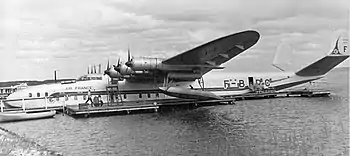 F-BDRC, the Latécoère 631 involved in the accident | |
| Accident | |
|---|---|
| Date | 1 August 1948 |
| Summary | Ditching, cause unknown, possible fire on board |
| Site | Atlantic Ocean |
| Aircraft | |
| Aircraft type | Latécoère 631 |
| Aircraft name | Lionel de Marnier |
| Operator | Air France |
| Registration | F-BDRC |
| Flight origin | Fort de France, Martinique |
| Destination | Port-Etienne, French West Africa |
| Occupants | 52 |
| Passengers | 40 |
| Crew | 12 |
| Fatalities | 52 |
| Survivors | 0 |
On 1 August 1948, Air France Flight 072 went missing over the Atlantic Ocean, presumably killing all 52 people on board. The accident led to the withdrawal of the Latécoère 631 from service by Air France. It was the deadliest aircraft accident in the Atlantic Ocean at the time and also the deadliest suffered by that type of aircraft.
Aircraft
The accident aircraft was Latécoère 631 F-BDRC, Lionel de Marnier, msn 06.[1][2] with a first flight on 9 November 1947.
Accident
The aircraft departed from Fort de France, Martinique at 14:50 GMT on 31 July, and was due to arrive at Port-Etienne, French West Africa at 01:00 GMT on 1 August. It was carrying a crew of twelve and 40 passengers.[3] It was reported that a mayday had been received by an American radio station in the Azores just after midnight on 1 August. The aircraft's position was estimated as 1,100 nautical miles (2,000 km) north of the Cape Verde Islands.[4] Two Air France aircraft, a French Air Force aircraft and a French Navy ship were sent to search for the aircraft.[3] The United States Coast Guard sent USCGC Campbell to assist in the search.[5] The Portuguese authorities allowed aircraft searching for the missing Latécoère 631 to use the Ilha do Sal Airport, which was not then open to traffic.[6] Two Portuguese Air Force Boeing B-17 Flying Fortresses also joined the search.[5] The United States Air Force sent a Flying Fortress and seven Boeing B-29 Superfortresses to join the search.[7]
On 3 August, the French weather ship Leverrier reported receiving a distress message from the aircraft. A second message was received early the next morning. The American Flying Fortress also reported receiving a "faint and garbled" distress message that day.[7] USCGC Campbell reported finding two seats from the aircraft at a position 1,570 nautical miles (2,910 km) east of Puerto Rico. An aircraft later reported seeing wreckage 15 nautical miles (28 km) from the position the seats were found.[5] Some of the wreckage showed evidence of fire.[8] The search for survivors was called off on 9 August.[9] Following the accident, which was the worst crash in the Atlantic Ocean at the time and also the worst ever suffered by the Latécoère 631,[2] the type was withdrawn from service by Air France.[1]
References
- 1 2 "Latécoère 631". Aeroplane. Cudham: Kelsey Publishing (January 2014): 102–03. ISSN 0143-7240.
- 1 2 "F-BDRC Accident description". Aviation Safety Network. Retrieved 3 December 2013.
- 1 2 "52 ON BOARD MISSING SEAPLANE". The Times. No. 51139. London. 2 August 1948. p. 4.
- ↑ "THE MISSING FRENCH FLYING-BOAT". The Times. No. 51140. London. 3 August 1948. p. 4.
- 1 2 3 "MISSING FLYING-BOAT". The Times. No. 51143. London. 6 August 1948. p. 4.
- ↑ "The Missing French Flying Boat". The Times. No. 51141. London. 4 August 1948. p. 4.
- 1 2 "SEARCH FOR FRENCH FLYING BOAT". The Times. No. 51142. London. 5 August 1948. p. 4.
- ↑ "Another Mysterious Disappearance". Flight: 170. 12 August 1948. Archived from the original on 5 March 2016.
- ↑ "SEARCH FOR FLYING-BOAT ABANDONED". The Times. No. 51146. London. 10 August 1948. p. 4.